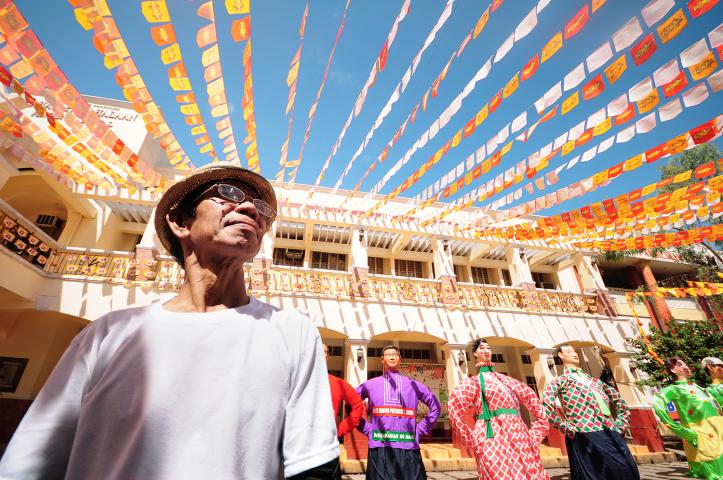ADVERTISEMENT
Filtered By: Lifestyle
Lifestyle
The art and life of Angono’s higantes
By NIKKA CORSINO
ANGONO, Rizal—There was pride in Leonardo Tajan's voice when he recounted the time his father charged him to look after his most important creations: the Pamilya ng Higante (family of giants), a three-piece set of giant papier-mâché figures representing a traditional Filipino family, also arguably a big part of the modern cultural history of Angono town in Rizal province.
"Ako lang sa aming magkakapatid ang nahilig sa sining, kaya ako rin lang ang pinag-iwanan niyan ng aking tatay," Tajan said, pointing to the larger-than-life figures—one adult male and one adult female, each about ten feet tall, and a male child about half the adults' height. (I was the only one among my siblings who took to the arts so my father decided to pass them on to me.)
 Pamilya ng Higantes by Artemio Tajan are on display for the annual festival. The adult male (right) is the oldest existing higante of Angono.
Pamilya ng Higantes by Artemio Tajan are on display for the annual festival. The adult male (right) is the oldest existing higante of Angono. Each year hence, in November, these giant figures would parade down Angono's streets for the Higantes Festival, which coincides with the Catholic feast of the town's patron, Saint Clement.
From Spanish-era folklore to Gangnam
As folklore would have it, peasants of Angono made the very first higante in protest of unfair treatment from their Spanish landlord. Formed to resemble their landlord's face, the higante was said to have had big bulging eyes, an unsmiling mouth, and a dour, hands-on-hips stance—exactly how the modern-day higante looks like. The angry peasants then paraded it down the streets in mockery.
It was not until Francisco proposed the usage of these giant human papier-mâché figures that they were associated with cheer and festivities. Since then, the typical Pinoy higante has taken on many other forms.
This year for instance, during a smaller-scale Higantes parade held the weekend before Saint Clement's feast day, higantes in the form of Moriones warriors paraded alongside the traditional Filipino figures. One group added a touch of pop, creating a giant version of the Korean pop singer Psy dancing to his popular “Oppa Gangnam Style.” Past parades also had higantes versions of Francisco and Angono's other National Artist (for Music), Maestro Lucio San Pedro. Still, others were inspired by mythical creatures.
The making of the Pamilya ng Higante
Tajan's father created a female pair for his first higante not long after the adult male. The wife had similar large eyes and stony stance, and its hair was pulled back into a bun. The higante couple would then be paraded down during the Pagoda, the religious procession for Saint Clement's feast day.
“The couple would be the only higantes parading during the Pagoda, and then the townspeople started asking my father to give them a child,” the younger Tajan said in Tagalog.
In the 1970s, Tajan’s father made a male child about half the size of the adult higantes, hence the moniker Pamilya ng Higante. They were clad in traditional, brightly colored Filipino garb—baro't saya for the wife, and long-sleeved shirts and pants for the father and child. The family has graced the Higantes Festival parade ever since. Such is the place of this giant family in the town's life that they were painted on one of its river dikes, arranged from the tallest to the smallest, with a corresponding depth measurement to help residents gauge the water levels and prepare them for possible flooding.
The art of higante-making
Tajan—who works as a barber in town—says a full-sized higante takes about a month to finish. Its head is the most detail-intensive part, and takes up more than a week's work. The hollow body is made of assembled bamboo sticks to keep it lightweight for its carrier, who would fit himself or herself inside the higante and walk the entire parade route, the feet remaining visible as the higante is lifted about half a foot from the ground.
 Leonardo Tajan stands in front of their family's higantes, which are on public display for the Higantes Festival.
Leonardo Tajan stands in front of their family's higantes, which are on public display for the Higantes Festival. Taking from his father's original head design, Tajan has since been making his own higantes, the latest of which were commissioned pieces of the town's mayor and vice mayor. He uses cellulose fiber to keep the integrity of the papier-mâché, without which, he says, the face of the higante would easily deform. This is the same upkeep he's been doing to his father's original works, which—at closer inspection—looks a lot like their newer counterparts.
And although these higantes are but a fraction of Angono's art scene—the town, after all, is home to illustrious artist families with their impressive art galleries; and elaborate wall carvings and life-size stone sculptures on every street corner—little-known artists like Tajan contribute just as much into keeping traditions, family and otherwise, alive.--KDM, GMA News Photos by Owen Ballesteros
More Videos
Most Popular




